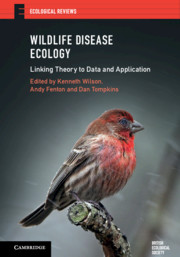Book contents
- Wildlife Disease Ecology
- Ecological Reviews
- Wildlife Disease Ecology
- Copyright page
- Contents
- Contributors
- Preface: Wildlife Disease Ecology
- Glossary of Terms
- Part I Understanding within-host processes
- Part II Understanding between-host processes
- Chapter Eight Using insect baculoviruses to understand how population structure affects disease spread
- Chapter Nine Infection and invasion: study cases from aquatic communities
- Chapter Ten Parasite-mediated selection in red grouse – consequences for population dynamics and mate choice
- Chapter Eleven Emergence, transmission and evolution of an uncommon enemy: Tasmanian devil facial tumour disease
- Chapter Twelve Bovine tuberculosis in badgers: sociality, infection and demography in a social mammal
- Chapter Thirteen Mycoplasma ovipneumoniae in bighorn sheep: from exploration to action
- Chapter Fourteen Manipulating parasites in an Arctic herbivore: gastrointestinal nematodes and the population regulation of Svalbard reindeer
- Part III Understanding wildlife disease ecology at the community and landscape level
- Index
- Plate Section (PDF Only)
- References
Chapter Eight - Using insect baculoviruses to understand how population structure affects disease spread
from Part II - Understanding between-host processes
Published online by Cambridge University Press: 28 October 2019
- Wildlife Disease Ecology
- Ecological Reviews
- Wildlife Disease Ecology
- Copyright page
- Contents
- Contributors
- Preface: Wildlife Disease Ecology
- Glossary of Terms
- Part I Understanding within-host processes
- Part II Understanding between-host processes
- Chapter Eight Using insect baculoviruses to understand how population structure affects disease spread
- Chapter Nine Infection and invasion: study cases from aquatic communities
- Chapter Ten Parasite-mediated selection in red grouse – consequences for population dynamics and mate choice
- Chapter Eleven Emergence, transmission and evolution of an uncommon enemy: Tasmanian devil facial tumour disease
- Chapter Twelve Bovine tuberculosis in badgers: sociality, infection and demography in a social mammal
- Chapter Thirteen Mycoplasma ovipneumoniae in bighorn sheep: from exploration to action
- Chapter Fourteen Manipulating parasites in an Arctic herbivore: gastrointestinal nematodes and the population regulation of Svalbard reindeer
- Part III Understanding wildlife disease ecology at the community and landscape level
- Index
- Plate Section (PDF Only)
- References
Summary
Approaches to understanding infectious disease dynamics often emphasise studies of multiple hosts or pathogens, but for many diseases, population structure may play a more important role. Changes in population structure may stem from heterogeneity of infection risk in the host population, pathogen polymorphism, spatial structure, or host population size structure. We review previous work demonstrating effects of population structure on baculoviruses of two insects in North America, focusing on heterogeneity in infection risk, which has consequences for both single epizootics and long-term host–pathogen population cycles. Baculoviruses’ simple biology and their insect hosts’ small size means that insect–baculovirus interactions provide experimentally tractable systems for testing models. Our research has combined mechanistic models with data using a combination of statistical model selection, Bayesian statistics, and time-series probes, allowing us to show how host variation affects disease dynamics and pathogen coexistence, and how variation is affected by host-plant resource quality, climate change, and host population size structure. We also discuss how Bayesian mixture models can make it possible to combine multiple sources of data collected across a range of scales.
Keywords
- Type
- Chapter
- Information
- Wildlife Disease EcologyLinking Theory to Data and Application, pp. 225 - 261Publisher: Cambridge University PressPrint publication year: 2019
References
- 1
- Cited by



